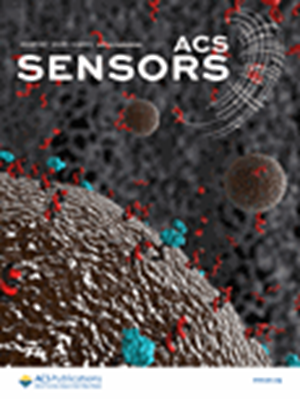Calix[6]arene-Functionalized Photonic Hydrogel Biosensor for Naked-Eye Cholesterol Detection Based on Supramolecular Host–Guest Interactions
IF 8.2
1区 化学
Q1 CHEMISTRY, ANALYTICAL
引用次数: 0
Abstract
Cholesterol (CHO) is an essential constituent of human cellular tissues and a crucial activity indicator for the clinical diagnosis and prevention of various diseases. Abnormal CHO levels can lead to various cardiovascular diseases, including coronary heart disease, cerebral thrombosis, and atherosclerosis. Thus, developing simple and effective methods for CHO detection is of great significance. Herein, a novel calix[6]arene-modified photonic hydrogel biosensor (PAAH@SCX6) was developed for naked-eye monitoring of CHO based on supramolecular host–guest interactions between 4-sulfocalix[6]arene (SCX6) and CHO molecules. This sensor was constructed by embedding Fe3O4 colloidal nanocrystal cluster chains into a poly(acrylamide-co-acrylic acid) smart hydrogel (PAAH), followed by incorporation of plentiful SCX6 units into the PAAH via hydrogen bonding interactions. The specific recognition of SCX6 to CHO leads to the volume expansion of the hydrogel, causing a shift in the photonic band gap and a change in the hydrogel’s structural color. The sensor demonstrated a linear detection range of 2.83–5.20 mM, covering the typical CHO levels in the human body. Importantly, the PAAH@SCX6 biosensor showed high selectivity and satisfactory stability, making it highly suitable for practical applications. Such a photonic hydrogel-based biosensor provides a convenient, simple, and efficient strategy for visual CHO detection.

基于超分子主客体相互作用的用于裸眼胆固醇检测的 Calix[6]arene 功能化光子水凝胶生物传感器
胆固醇(CHO)是人体细胞组织的重要成分,也是临床诊断和预防各种疾病的重要活性指标。CHO 水平异常可导致各种心血管疾病,包括冠心病、脑血栓和动脉粥样硬化。因此,开发简单有效的 CHO 检测方法意义重大。本文基于 4-磺基[6]炔(SCX6)和 CHO 分子之间的超分子主客体相互作用,开发了一种新型的钙[6]炔修饰光子水凝胶生物传感器(PAAH@SCX6),用于肉眼监测 CHO。这种传感器是通过将 Fe3O4 胶体纳米晶簇链嵌入聚丙烯酰胺-丙烯酸智能水凝胶(PAAH),然后通过氢键相互作用将大量 SCX6 单元掺入 PAAH 而构建的。SCX6 与 CHO 的特异性识别导致水凝胶体积膨胀,从而引起光子带隙的移动和水凝胶结构颜色的变化。传感器的线性检测范围为 2.83-5.20 mM,涵盖了人体内典型的 CHO 水平。重要的是,PAAH@SCX6 生物传感器具有高选择性和令人满意的稳定性,因此非常适合实际应用。这种基于光子水凝胶的生物传感器为肉眼检测 CHO 提供了一种方便、简单和高效的策略。
本文章由计算机程序翻译,如有差异,请以英文原文为准。
求助全文
约1分钟内获得全文
求助全文
来源期刊

ACS Sensors
Chemical Engineering-Bioengineering
CiteScore
14.50
自引率
3.40%
发文量
372
期刊介绍:
ACS Sensors is a peer-reviewed research journal that focuses on the dissemination of new and original knowledge in the field of sensor science, particularly those that selectively sense chemical or biological species or processes. The journal covers a broad range of topics, including but not limited to biosensors, chemical sensors, gas sensors, intracellular sensors, single molecule sensors, cell chips, and microfluidic devices. It aims to publish articles that address conceptual advances in sensing technology applicable to various types of analytes or application papers that report on the use of existing sensing concepts in new ways or for new analytes.
 求助内容:
求助内容: 应助结果提醒方式:
应助结果提醒方式:


